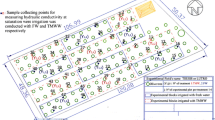Abstract
Behaviour of different water soluble and exchangeable bases in a brackishwater fish pond soil was studied under four levels of water salinity, in combination with and without organic matter application. The results showed average content of water soluble bases to increase with increase in water salinity. The bases were dominated by Na+ followed by Mg++, Ca++ and K+ in decreasing order. SAR values of water increased with increase in water salinity and decreased slightly on organic matter treatment.
Total content of exchangeable bases in soils was fairly high and was dominated by Ca++ and Mg++, followed by Na+ and K+ respectively. Amount of exchangeable Ca++ + Mg++ decreased while that of Na+ increased with increase in water salinity levels. Amount of exchangeable K+ did not show any appreciable change. Application of organic matter tended to increase the exchangeable Ca++ + Mg++ content and decrease the amount of exchangeable Na+ in the soil, while exchangeable K+ content remained practically unaffected due to organic matter treatment.
Similar content being viewed by others
References
Chattopadhyay, G. N. 1978. Studies on the chemistry of brackishwater fish pond soils and water. Ph. D. Thesis. Bidhan Chandra Agricultural University, India.
Harvey, H. W. 1960 The chemistry and fertility of seawaters. Cambridge University Press. London
Hickling, C. F. 1971. Fish Culture. Faber & Faber, London.
Jackson, M. L. 1967. Soil chemical analysis. Prentice Hall of India Pvt. Ltd., New delhi.
Jhingran, V. G. 1975. Fish and Fisheries of India. Hindusthan Publishing Corporation (India), New Delhi.
Mandal, L. N. 1962. Effect of salinity on the transformation of nitrogen in the brackishwater fish farm soils. J. Indian Soc. Soil Sci. 10 (4): 255–261.
Mitra, S. P. & Shankar, H. 1957. Amelioration of alkali soils by chemicals in combination with organic matter like weeds. Soil Sci. 83: 471–474.
Paliwal, K. V. 1972. Irrigation with saline water. Water Technology centre, Indian Agricultural Research Institute, New Delhi.
Pillay, T. V. R., Vijayaraghavan, M. R. & Thakurta, S. C. 1962. An ecological study of benthic flora in brackishwater bheris. Proc. Nat. Inst. Sci. India. 28 B (5): 416–431.
Piper, C. S. 1966. Soil and plant analysis. Hans Publishers, Bombay.
Reid, G. K. 1961. Ecology of inland waters and estuaries. Reinhold Publishing Corporation, New York.
Venkatraman, G. S. 1969. Cultivation of algae. Indian Council of Agricultural Research, New Delhi.
Wunder, W. 1949. Fortschrittliche Karpfenteichwirtschaft. Erwin Nagele, Stuttgart.
Author information
Authors and Affiliations
Additional information
Formed part of a Ph.D. thesis submitted to Bidhan Chandra Agricultural University, India in 1978
Formed part of a Ph.D. thesis submitted to Bidhan Chandra Agricultural University, India in 1978
Rights and permissions
About this article
Cite this article
Chattopadhyay, G.N., Mandal, L.N. Effect of different water salinity levels and organic matter application on the composition of water soluble and exchangeable bases in a brackishwater fish pond soil. Hydrobiologia 74, 33–37 (1980). https://doi.org/10.1007/BF00009012
Received:
Published:
Issue Date:
DOI: https://doi.org/10.1007/BF00009012




